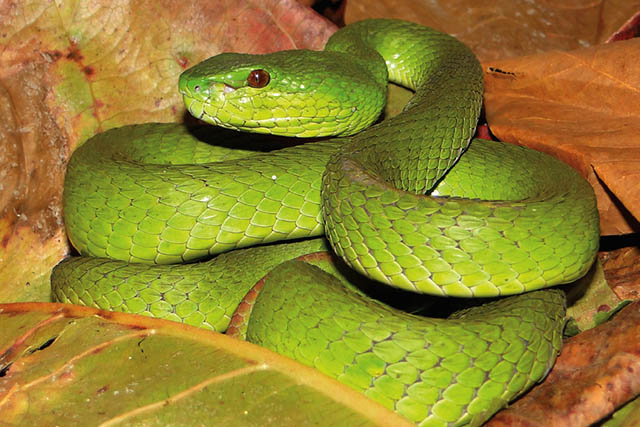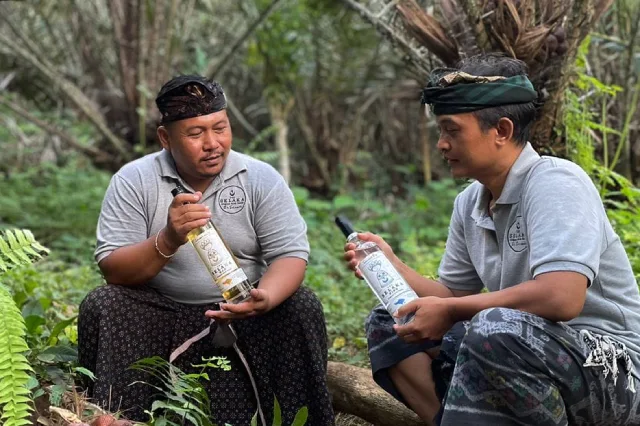Things to Do in Bali
Island Pit Viper in Bali – the Snake that bites most people in Bali
The Island Pit Viper (with red eyes), scientifically known as Trimeresurus insularis and locally referred to as Ular Hijau or Lipi Gadang, is a venomous snake species frequently encountered in Bali. These pit vipers can grow up to 1 meter in length and are distinguished by their vibrant green color and the characteristic white or yellowish lip line. Equipped with heat-sensing pits, these vipers can detect the body heat of their prey, making them effective nocturnal hunters. They are specifically found in the Lesser Sunda Islands of Indonesia, including Bali, Lombok, Sumbawa, and Komodo, yet might have different colour on ths other islands, like blue or yellow.
The venom of the Island Pit Viper is hemotoxic, causing intense pain, swelling, and local tissue damage. In severe cases, envenomations can lead to systemic bleeding and require urgent medical care. Despite their dangerous venom, these snakes are generally defensive rather than aggressive and will bite primarily when threatened or accidentally stepped on. Nevertheless it is still the snake that bites most people in Bali, mostly because it is so difficult to see it because of its magnificent green colour which is an excellent camouflage. And during night these snakes lie down on the ground, and people simply might step on them. The snake basically just bites then it feels threatened.
Commonly found in forests, gardens, and plantations, the Island Pit Viper plays a significant role in controlling the population of small mammals and other prey. Their presence in lowland areas and foothills of Bali highlights the island’s rich biodiversity. To avoid bites, it’s essential to stay vigilant, especially at night, and use flashlights when walking through their habitats. Understanding their behavior and ecological importance can help in appreciating these fascinating reptiles while ensuring safe interactions.
Island Pit Viper
- Latin Name: Trimeresurus insularis
- Bahasa Name: Ular Hijau, Lipi Gadang
- Length: Up to 1 meter
- Danger Level: Dangerous. Defensive and will bite if threatened
- Venom: Hemotoxic, causing intense pain, swelling, and tissue damage. Severe envenomations can lead to systemic bleeding and require urgent medical care.
- Color: Green with white or yellowish lips, reddish or brownish tail
- Specific Markers: White or yellowish lip line and heat-sensing pits. **Eye Shape:** Vertical elliptical pupils. **Head Shape:** Triangular, distinct from the neck. **Eye Color:** in Bali red eyes.
- Habitat: Forests, gardens, and plantations
- Activity: Nocturnal (night active)
- Prevalence: Often found
- Region: Lowland areas and foothills
- Encounter Risk: Moderate. Most bites occur from accidental encounters, particularly at night. Using flashlights and staying aware can help avoid bites.

Source: Wikimedia Common
Conservation Status of the Island Pit Viper (Trimeresurus insularis)
Not Evaluated (NE) by IUCN globally. Locally, it is common on Indonesian islands including Bali.
What Travelers want to know about Snakes in Bali
Yes, Bali is home to several dangerous snakes, including the King Cobra, Blue Krait, and Malayan Pit Viper. While these snakes are venomous, they are generally shy and avoid human contact, encounters with tourists are very very rare.
The Pythons can also be dangerous, depending ion their size and whether they feel threatened. It's important to be cautious, especially in rural and forested areas.
It is uncommon, but not impossible, to find snakes in Bali villas. Most villas are well-maintained and have measures in place to prevent wildlife from entering and gardeners keep the gardens free of potential habitats as much as possible. However, occasional sightings of non-venomous snakes like the Common Wolf Snake may occur, particularly in areas close to nature.
Snakes can be found in Ubud due to its lush, natural environment, but they are not commonly encountered by visitors. The area’s forests and rice fields provide habitats for various snake species.</p]
The most common snakes in Bali include the Common Wolf Snake and the Oriental Rat Snake. These non-venomous snakes are frequently found in gardens, forests, and near human settlements.
Bali hosts several venomous snakes, including the King Cobra, Blue Krait, Malayan Pit Viper, Javan Spitting Cobra, Green Tree Pit Viper, Island Pit Viper, Asian Coral Snake, Red-Necked Keelback Snake, Yellow-Bellied Sea Snake, and the Banded Sea Krait. These snakes possess potent venom but are typically shy and avoid human contact.
Yes, there are. Venomous sea snakes in Bali include the Yellow-bellied Sea Snake and the Banded Sea Krait. These snakes are usually found in coastal waters and are generally not aggressive towards humans.
Yes, there are non-venomous snakes in Bali. Non-venomous snakes include the Burmese Python, Reticulated Python, Common Wolf Snake, Oriental Rat Snake, Brahminy Blind Snake, Green Cat Snake, Red-tailed Pipe Snake, and the Chinese Rat Snake. These snakes are harmless to humans and play a vital role in controlling pest populations.
Identifying snakes in Bali can be challenging due to the variety of species. Yes, identifying snakes in Bali involves looking at key markers such as color patterns, head shape, and habitat. For detailed information, refer to our specific snake pages guides available on our website.
Yes. The King Cobra in Bali is known for its impressive size and potent venom. It is typically found in forests and rural areas. Despite its fearsome reputation, it tends to avoid human contact.
The Banded Krait is a venomous snake found in Bali, recognized by its distinctive black and yellow bands. It is generally nocturnal and prefers wetland habitats.</p]
The thin green snake in Bali is likely the (mostly) harmless Vine Snake or the Green Tree Pit Viper or the Island Pit Viper,, which is the snake that causes the most bites in Bali and is specifically found in the Lesser Sunda Islands of Indonesia, including Bali, Lombok, Sumbawa, and Komodo.
The striped snake in Bali could be the Blue Krait or the Banded Krait, both of which have distinct banding patterns and are venomous. These snakes are nocturnal and typically found in rural areas.
The likelihood of seeing a snake in Bali depends on your location and activities. While urban and tourist areas have fewer sightings, rural and forested areas have higher chances of encounters. However, snakes generally avoid human contact.
Besides snakes, other dangerous animals in Bali include certain species of spiders and scorpions. However, encounters with these creatures are rare, and they generally avoid human contact, and are not very venomous. It's more dangerous playing with a monkey in the Monkey Forest.
A key difference is how the toxins enter the body: venomous animals, like most snakes, inject toxins through a bite or sting, while poisonous animals release toxins when touched or ingested. The terms are often confused, and many people incorrectly call most snakes "poisonous" when they are actually "venomous".
List of Snakes in Bali
10 most common venomous Snakes in Bali
- King Cobra (Ophiophagus hannah)
- Blue Krait / Malayan Krait (Bungarus caeruleus)
- Banded Krait (Bungarus fasciatus)
- Malayan Pit Viper (Calloselasma rhodostoma)
- Javan Spitting Cobra (Naja sputatrix)
- Green Tree Pit Viper (Trimeresurus albolabris)
- Island Pit Viper (Trimeresurus insularis)
- Asian Coral Snake (Calliophis intestinalis)
- Red-Necked Keelback Snake (Rhabdophis subminiatus)
- Vine Snake (Ahaetulla prasina)
Venomous Sea Snakes around Bali
Common Non-Venomous Snakes in Bali
- Oriental Rat Snake (Ptyas mucosa)
- Common Wolf Snake (Lycodon capucinus)
- Brahminy Blind Snake (Indotyphlops braminus)
- Green Cat Snake (Boiga cyanea)
- Red-tailed Pipe Snake (Cylindrophis ruffus)
- Chinese Rat Snake (Ptyas korros)
- Bronzeback Snake (Dendrelaphis pictus)
- Sunbeam Snake (Xenopeltis unicolor)






















